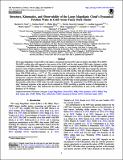Por favor, use este identificador para citar o enlazar a este item:
http://hdl.handle.net/10261/348821COMPARTIR / EXPORTAR:
 SHARE SHARE
 CORE
BASE CORE
BASE
|
|
| Visualizar otros formatos: MARC | Dublin Core | RDF | ORE | MODS | METS | DIDL | DATACITE | |

| Título: | Structure, kinematics, and observability of the large magellanic cloud’s dynamical friction wake in cold versus fuzzy dark matter |
Autor: | Foote, Hayden R.; Besla, Gurtina; Mocz, Philip; Garavito Camargo, Nicolás; Lancaster, Lachlan; Sparre, Martin; Cunningham, Emily C.; Vogelsberger, Mark; Gómez, Facundo A.; Laporte, Chervin F. P. | Fecha de publicación: | 2023 | Editor: | IOP Publishing | Citación: | Astrophysical Journal 954(2): 163 (2023) | Resumen: | The Large Magellanic Cloud (LMC) will induce a dynamical friction (DF) wake on infall to the Milky Way (MW). The MW's stellar halo will respond to the gravity of the LMC and the dark matter (DM) wake, forming a stellar counterpart to the DM wake. This provides a novel opportunity to constrain the properties of the DM particle. We present a suite of high-resolution, windtunnel-style simulations of the LMC's DF wake that compare the structure, kinematics, and stellar tracer response of the DM wake in cold DM (CDM), with and without self-gravity, versus fuzzy DM (FDM) with ma = 10−23 eV. We conclude that the self-gravity of the DM wake cannot be ignored. Its inclusion raises the wake's density by ∼10%, and holds the wake together over larger distances (∼50 kpc) than if self-gravity is ignored. The DM wake's mass is comparable to the LMC's infall mass, meaning the DM wake is a significant perturber to the dynamics of MW halo tracers. An FDM wake is more granular in structure and is ∼20% dynamically colder than a CDM wake, but with comparable density. The granularity of an FDM wake increases the stars' kinematic response at the percent level compared to CDM, providing a possible avenue of distinguishing a CDM versus FDM wake. This underscores the need for kinematic measurements of stars in the stellar halo at distances of 70–100 kpc. | Versión del editor: | https://doi.org/10.3847/1538-4357/ace533 | URI: | http://hdl.handle.net/10261/348821 | DOI: | 10.3847/1538-4357/ace533 | E-ISSN: | 1538-4357 |
| Aparece en las colecciones: | (ICE) Artículos |
Ficheros en este ítem:
| Fichero | Descripción | Tamaño | Formato | |
|---|---|---|---|---|
| structurematter.pdf | 2,77 MB | Adobe PDF |  Visualizar/Abrir |
CORE Recommender
SCOPUSTM
Citations
2
checked on 25-abr-2024
Page view(s)
13
checked on 29-abr-2024
Download(s)
2
checked on 29-abr-2024
Google ScholarTM
Check
Altmetric
Altmetric
Este item está licenciado bajo una Licencia Creative Commons

